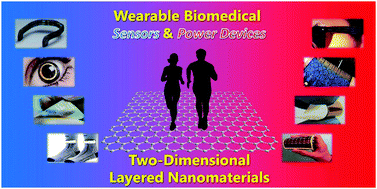当前位置:
X-MOL 学术
›
Mater. Chem. Front.
›
论文详情
Our official English website, www.x-mol.net, welcomes your feedback! (Note: you will need to create a separate account there.)
Engineering two-dimensional layered nanomaterials for wearable biomedical sensors and power devices
Materials Chemistry Frontiers ( IF 7 ) Pub Date : 2018-09-11 00:00:00 , DOI: 10.1039/c8qm00356d Xianyi Cao 1, 2, 3, 4 , Arnab Halder 1, 2, 3, 4 , Yingying Tang 1, 2, 3, 4 , Chengyi Hou 5, 6, 7, 8, 9 , Hongzhi Wang 5, 6, 7, 8, 9 , Jens Øllgaard Duus 1, 2, 3, 4 , Qijin Chi 1, 2, 3, 4
Materials Chemistry Frontiers ( IF 7 ) Pub Date : 2018-09-11 00:00:00 , DOI: 10.1039/c8qm00356d Xianyi Cao 1, 2, 3, 4 , Arnab Halder 1, 2, 3, 4 , Yingying Tang 1, 2, 3, 4 , Chengyi Hou 5, 6, 7, 8, 9 , Hongzhi Wang 5, 6, 7, 8, 9 , Jens Øllgaard Duus 1, 2, 3, 4 , Qijin Chi 1, 2, 3, 4
Affiliation

|
High-quality personalized medicine and health management have increasingly demanded wearable biomedical electronic devices (WBEDs) towards being more flexible and stretchable. This modern-life oriented trend has driven tremendous efforts from both academia and industrial enterprises devoted to research and development of new-generation WBEDs for improving the quality of home medicine. The development of such WBEDs crucially depends on design and assembly of new-types of materials. Thanks to superior physicochemical properties derived by their two-dimensional (2D) layered structural nature, 2D layered nanomaterials (2DLNs) hold notable advantages and are offering a promising material platform for energy, sensing, and wearable electronic applications. By using 2DLNs as versatile building modules, a number of technical breakthroughs have recently been achieved for manufacturing state-of-the-art 2DLNs-supported flexible/stretchable sensors and power devices, which could help WBEDs further achieve enhanced flexibility/stretchability and realize remarkable performance improvements. This review aims to offer timely and comprehensive evaluations of the current status, remaining challenges, and future perspectives of 2DLNs-supported wearable biomedical sensors and power devices, with the emphasis on the latest advancements and the significance of 2DLNs in device design and fabrication.
中文翻译:

用于可穿戴生物医学传感器和功率器件的二维二维分层纳米材料
高质量的个性化医学和健康管理对可穿戴生物医学电子设备(WBED)的需求日益增加,以使其更加灵活和可扩展。这种以现代生活为导向的趋势推动了致力于研究和开发新一代WBED的学术界和工业企业的巨大努力,以提高家庭医学的质量。此类WBED的开发至关重要地取决于新型材料的设计和组装。得益于其二维(2D)层状结构特性,其卓越的物理化学性能,使得2D层状纳米材料(2DLN)具有明显的优势,并为能源,传感和可穿戴电子应用提供了有前途的材料平台。通过将2DLN用作通用构建模块,最近,在制造支持2DLNs的最新柔性/可拉伸传感器和功率器件方面已经取得了许多技术突破,这可以帮助WBED进一步实现增强的柔性/可拉伸性并实现显着的性能改进。这篇综述旨在及时,全面地评估2DLN支持的可穿戴生物医学传感器和功率设备的现状,挑战和未来前景,重点是2DLN在设备设计和制造中的最新进展和意义。
更新日期:2018-09-11
中文翻译:

用于可穿戴生物医学传感器和功率器件的二维二维分层纳米材料
高质量的个性化医学和健康管理对可穿戴生物医学电子设备(WBED)的需求日益增加,以使其更加灵活和可扩展。这种以现代生活为导向的趋势推动了致力于研究和开发新一代WBED的学术界和工业企业的巨大努力,以提高家庭医学的质量。此类WBED的开发至关重要地取决于新型材料的设计和组装。得益于其二维(2D)层状结构特性,其卓越的物理化学性能,使得2D层状纳米材料(2DLN)具有明显的优势,并为能源,传感和可穿戴电子应用提供了有前途的材料平台。通过将2DLN用作通用构建模块,最近,在制造支持2DLNs的最新柔性/可拉伸传感器和功率器件方面已经取得了许多技术突破,这可以帮助WBED进一步实现增强的柔性/可拉伸性并实现显着的性能改进。这篇综述旨在及时,全面地评估2DLN支持的可穿戴生物医学传感器和功率设备的现状,挑战和未来前景,重点是2DLN在设备设计和制造中的最新进展和意义。



























 京公网安备 11010802027423号
京公网安备 11010802027423号